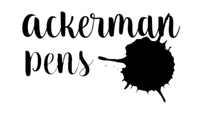Manga G nibs seem perfectly suited for fountain pens. They are well made, durable, and are very popular. We put Manga G nibs into our pens, and we like the results. Only problem is that Manga G nibs contain several design peculiarities that make them difficult to work in fountain pens.
The first problem is the flow pattern of the ink. In well designed fountain pen nibs, ink flows in a channel from the breather hole to the tip of the nib. No ink should flow outside the channel. If it does, you wipe it off the surface of your nib.
Dip nibs, such as the Manga G, are designed to hold ink all over the surface. Ink adheres through static electricity and surface tension, and gradually moves down the surface through the force of gravity to the tip. There is no ink "channel" in a dip nib. There is a slit, but the two sides are pressed tightly together, so nothing passes between them.
There is no space between the two tynes in an unmodified Zebra Manga G nib. With a modified nib, you can see daylight through the slit, and the width of the channel is tapered towards the tip. The encourages the flow of ink to the tip.
It is not worth the trouble to modify every pointed dip nib this way. Most of them aren't tough enough to take the grinding, and it's too expensive in any case.
The third problem, and sometimes the biggest problem, is the downward curvature of the tip. When viewed from the side, fountain pen nibs run straight across the top of the nib from back to the front. Manga G nibs dip at the tip, as shown below.
The dip provides extra spring and flex, but the curve causes a problem with ink flow. The flow depends on the match of feed to nib, but the feed can't come sufficiently forward because of the dipped tip. If the feed approaches the tip, the nib rides up on the feed, which breaks the flow of ink from the feed to the nib. The feed for a Manga G nib has to stop well short of the tip, which reduces the flow of ink to the tip.
The best solution we offer for ink flow problems with flexible nibs such as the Manga G is a device called an overfeed. This device rests on top of the nib, holds additional ink on the top of the nib, and feeds the ink to the tip whenever ink flow from the underfeed stops.
